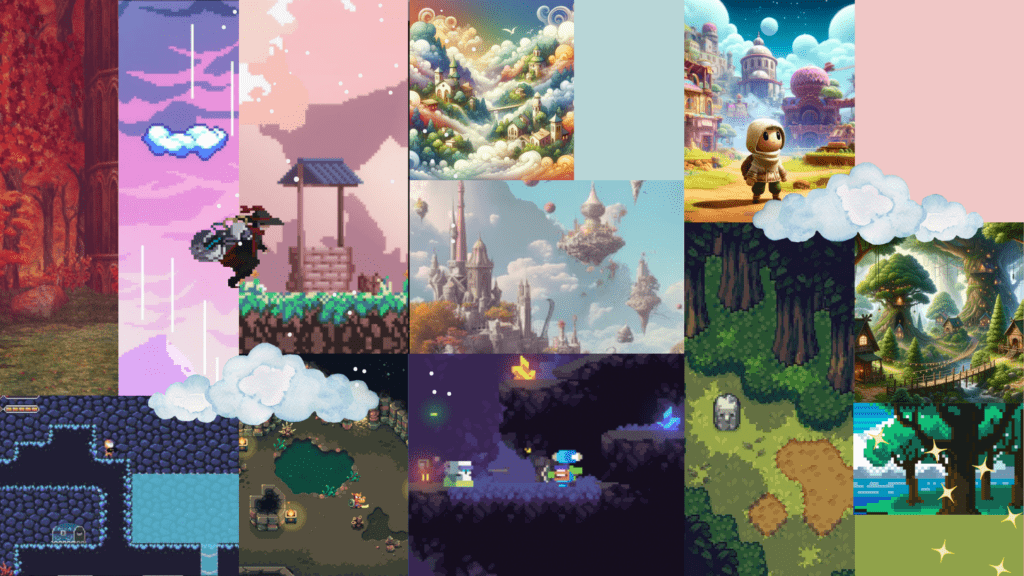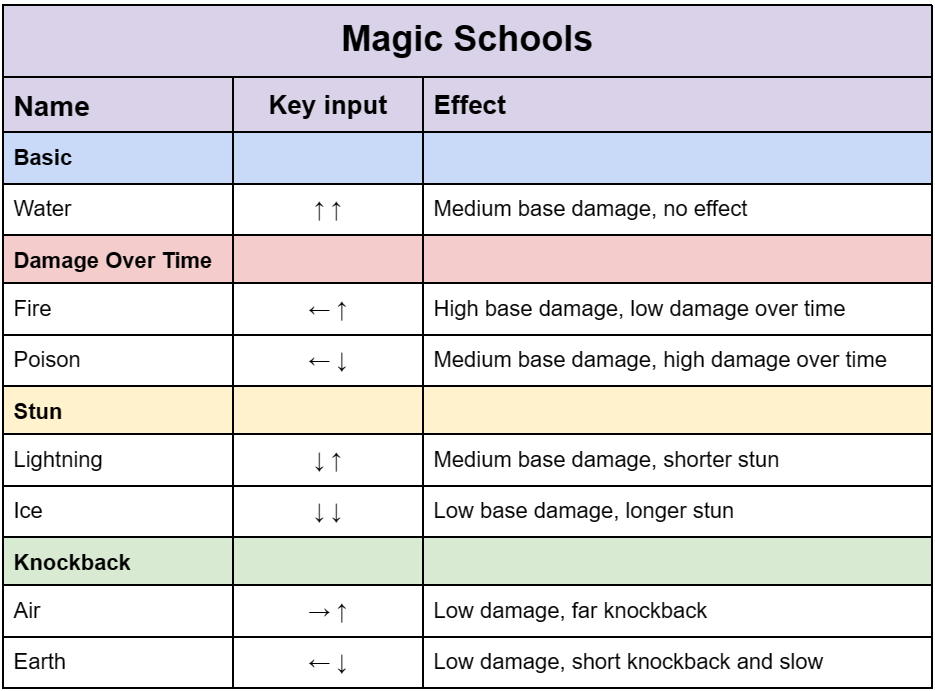Synopsis
You play as a character from a mystical group called the “Sky people”, a group of nomads who live among the clouds in the sky. From a young age, you’ve always been interested in what happens on the surface of the planet and what kinds of beings exist there. One day, as you are wandering the edge of a cloud trying to get a better look, you accidentally trip and fall all the way down to the ground! Make your way through various villages and environments to gather the supplies needed to make your way back home. This game direction would focus on exploration, challenge, and expression.
Tone
Light & Cozy: During the game, you will explore various villages with characters who are friendly and eager to assist you on your journey. Our village themes create a cozy and serene atmosphere.
Whimsical & Adventure: The themes of our villages incorporate a whimsical feel with bioluminescent plans and glowing crystals. The villages are meant to feel magical and inspire adventure and exploration.
Curious & Wonder: Throughout the journey, there is a desire to understand the world around you. Every village has a different quest for you and drives you to explore your surroundings further.
The Setting
You start your journey at the bustling Sky Village, your home in the clouds above. After falling from the sky, you awaken in a dimly lit network of tunnels with glowing crystals and echoing water droplets. You discover that there are other realms that you must journey through to get home. After exiting the cave, you journey through the waterside village, with colorful houses perched on stilts and fishermen hauling nets on wooden docks. The final stop before returning home to the sky is an enchanted forest village with twisting trees and bioluminescent paths.
Font Choices

Gameplay
Our gameplay will primarily have a 2D overhead perspective. Depending on the timeframe, we may design our boss battles to incorporate more fun perspective changes that would add in more dimensions to the fight with things like platforming and dodging.
The player will control their character’s movement using the WASD keys and we plan for the magic combat system to be activated using the arrow keys. As of now, we plan for the game to be played solely through the keyboard without requiring a mouse.
For the combat system, we plan to implement a simple system using magic, where the player can activate spells using the arrow keys (See Appendix A for an in-depth explanation of our magic system). The player will not have a health bar for simplicity and instead have a number of hearts that deplete on a hit.
The player will start each stage of the game in a village unique to the stage. At the edge of the village will be an entrance into the dungeon for that stage. The dungeon is divided into 3 sub-levels, each filled with unique mobs and loot. In the first two sub-levels, players will have to explore the randomly generated rooms to gather materials. In the last sub-level, the player will battle a boss to acquire the final material needed. At the end of each sub-level, the player may choose to exit the dungeon without penalty, keeping all gathered materials. Otherwise, if the player’s hearts are depleted during the dungeon, they will lose all materials gathered during that run. It is intended for the player to have to attempt the dungeon multiple times to collect all necessary materials and defeat the boss.
On completion of the dungeon and collection of all required materials, the player will be able to advance to the next stage.
Image Style/Group Moodboard

Key Challenges for Design
- Determining the size and layout of the procedurally generated cave rooms. We must have a good sense of the layout and structure of the sublevels of the room before we can dive into generating/designing them.
- Figuring out the specifics of the setting layout. This includes constructing the village itself, and figuring out how the caves connect to the villages. Finally, once we have a good sense of what the layout will look like, we will have to experiment in Godot to figure out what design constraints using this platform may present to us.
- Another challenge in terms of narrative design is figuring out how to make the narrative/gameplay not seem too repetitive. Currently, players proceed through sublevels of the cave and complete objectives but will be doing so for 3 different levels in the game. We must find a way to make the levels different enough so that the mechanics don’t feel overly repetitive, and also introduce each “village” in each level in a way that also does not feel repetitive.
Key Challenges for Tech
- Learning how to use Godot
- Fine-tuning our procedural generation algorithms (See Appendix B for a link to our current algorithms)
- Figuring out how to map multiple key inputs to actions for the magic system
- Boss battle programming
- Mob programming
- Learning state transitions
Key Challenges for Art
- Most of the challenges in terms of art will simply be finding the right assets and tilesets that fit the settings that we want to create. Although we have an artist on the team who has the ability to create the assets from scratch, our main priority for this game will be on the mechanics and narrative itself. If there is sufficient time left over after the game mechanics have been thoroughly tested, there’s potential for us to develop our own tilesets and drawings to accompany the game.
- Another thing we must consider is creating animations for the cutscenes we want to include in our game, which will help us contextualize the backstory of our main character. This may be time-consuming, thus creating another potential challenge in the art aspect of our game.
Who is this for?
This game is intended for players ages 8+. We envision people from all backgrounds to be able to immerse themselves in our fantasy world. The potential presence of fantasy violence may make this game inappropriate for younger audiences. Players who naturally have an interest in fantasy, folklore, role-playing, and dungeon crawling will probably be among the most ecstatic to try our game.
Appendix A: Magic System
To activate a spell, the player will have to complete a three-character input combination. Each input is one of the arrow keys. The first two inputs represent the school of magic the spell is from. The third input represents the form the magic will take. Every combination will have a different effect. The player starts off with only basic water magic and will acquire new spellbooks as the game progresses.
![]()
[Input 1 and 2] (RED)
Magic School: Water, Fire, Poison, Lightning, Ice, Air, Earth
[Input 3] (YELLOW)
Magic Type: Line, Circle, Projectile, Cone



Appendix B: Dungeon Procedural Generation Algorithms
GitHub Repository: https://github.com/collinjung/DungeonBuilding
Individual Concept Docs
Lucia L.: https://mechanicsofmagic.com/2024/05/06/p2-checkpoint-1-individual/
Hannah C.: https://mechanicsofmagic.com/2024/05/05/p2-individual-checkpoint-1/
Collin J.: https://mechanicsofmagic.com/2024/05/06/moodboard-collin-j/
Sophie J.: https://mechanicsofmagic.com/2024/05/06/sophie-jin-p2-checkpoint-1-individual/
Adrian R.: https://mechanicsofmagic.com/2024/05/07/p2-individual-checkpoint-adrian/
Individual Spotify Playlists
Lucia L.: https://open.spotify.com/playlist/62IxjdF4FezhLiYcLOmDsJ?si=1d5da21f358d4956
Hannah C.: https://open.spotify.com/playlist/1O0hoOI0bSLjhGyuBL4Zhy?si=e3e6a9e714144239
Collin J.: https://open.spotify.com/playlist/3Mh8MJ5y4kF81qzjlJTy1A?si=2eb1_XUvTwSj8yvBfKpmwQ&pi=u-SK_l9vU2RUaF
Sophie J.: https://open.spotify.com/playlist/0hkYjYZkRcysLYTXixjBna?si=83f54882ec0d45fb
Adrian R.: https://open.spotify.com/playlist/0CBcxNSe6uuAHPlBVqOJXI?si=7b63dcbc9cf54efe




